
Concept explainers
(a)
To sketch: the graph of the functions, to find where the function is increasing and decreasing and approximate any
(a)
Answer to Problem 74E
The function is decreasing implies decreasing interval is
Explanation of Solution
Given information:
Given function
Calculation:
Consider the function
Use the T1-83 calculator.
Enter the expression in the T1-83 calculator after pressing
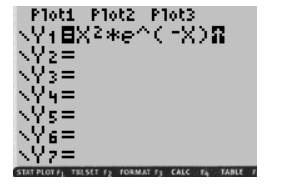
Press the window button and adjust the window as shown below:
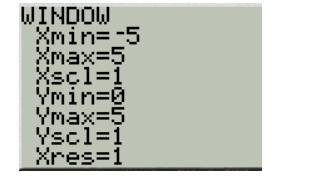
Click on the graph button and below is the graph of the expression
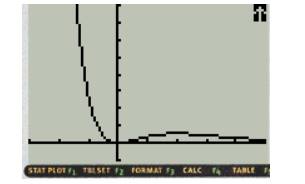
Use the TRACE button and then the arrow keys to move around the function curve. Observe the graph and find that the function is increasing between 0 and 2. Hence increasing interval is
Now with the help of TRACE option the peak and valley of the curve is found to be at 2 and 0 respectively. Hence the relative maximum occurs at
(b)
To sketch: the graph of the functions, to find where the function is increasing and decreasing and approximate any relative maximum or minimum values.
(b)
Answer to Problem 74E
Decreasing interval is
Explanation of Solution
Given information:
Given function
Calculation:
Consider the function
Use the T1-83 calculator.
Enter the expression in the T1-83 calculator after pressing
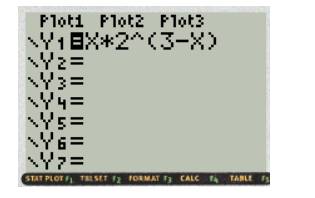
Press the WINDOW button and adjust the window as shown below:
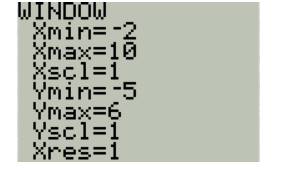
Click on the graph button and below is the graph of the expression
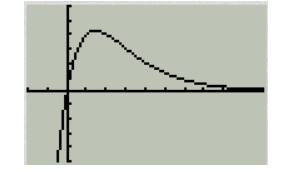
Use the TRACE button and then the arrow keys to move around the function curve. Observe the graph and find the function is decreasing between 1.44 and infinite. Hence decreasing interval is
Hence the relative maximum occurs at
Chapter 3 Solutions
EBK PRECALCULUS W/LIMITS
- A 20 foot ladder rests on level ground; its head (top) is against a vertical wall. The bottom of the ladder begins by being 12 feet from the wall but begins moving away at the rate of 0.1 feet per second. At what rate is the top of the ladder slipping down the wall? You may use a calculator.arrow_forwardExplain the focus and reasons for establishment of 12.4.1(root test) and 12.4.2(ratio test)arrow_forwarduse Integration by Parts to derive 12.6.1arrow_forward
- Explain the relationship between 12.3.6, (case A of 12.3.6) and 12.3.7arrow_forwardExplain the key points and reasons for the establishment of 12.3.2(integral Test)arrow_forwardUse 12.4.2 to determine whether the infinite series on the right side of equation 12.6.5, 12.6.6 and 12.6.7 converges for every real number x.arrow_forward
- use Corollary 12.6.2 and 12.6.3 to derive 12.6.4,12.6.5, 12.6.6 and 12.6.7arrow_forwardExplain the focus and reasons for establishment of 12.5.1(lim(n->infinite) and sigma of k=0 to n)arrow_forwardExplain the focus and reasons for establishment of 12.5.3 about alternating series. and explain the reason why (sigma k=1 to infinite)(-1)k+1/k = 1/1 - 1/2 + 1/3 - 1/4 + .... converges.arrow_forward
 Calculus: Early TranscendentalsCalculusISBN:9781285741550Author:James StewartPublisher:Cengage Learning
Calculus: Early TranscendentalsCalculusISBN:9781285741550Author:James StewartPublisher:Cengage Learning Thomas' Calculus (14th Edition)CalculusISBN:9780134438986Author:Joel R. Hass, Christopher E. Heil, Maurice D. WeirPublisher:PEARSON
Thomas' Calculus (14th Edition)CalculusISBN:9780134438986Author:Joel R. Hass, Christopher E. Heil, Maurice D. WeirPublisher:PEARSON Calculus: Early Transcendentals (3rd Edition)CalculusISBN:9780134763644Author:William L. Briggs, Lyle Cochran, Bernard Gillett, Eric SchulzPublisher:PEARSON
Calculus: Early Transcendentals (3rd Edition)CalculusISBN:9780134763644Author:William L. Briggs, Lyle Cochran, Bernard Gillett, Eric SchulzPublisher:PEARSON Calculus: Early TranscendentalsCalculusISBN:9781319050740Author:Jon Rogawski, Colin Adams, Robert FranzosaPublisher:W. H. Freeman
Calculus: Early TranscendentalsCalculusISBN:9781319050740Author:Jon Rogawski, Colin Adams, Robert FranzosaPublisher:W. H. Freeman
 Calculus: Early Transcendental FunctionsCalculusISBN:9781337552516Author:Ron Larson, Bruce H. EdwardsPublisher:Cengage Learning
Calculus: Early Transcendental FunctionsCalculusISBN:9781337552516Author:Ron Larson, Bruce H. EdwardsPublisher:Cengage Learning





